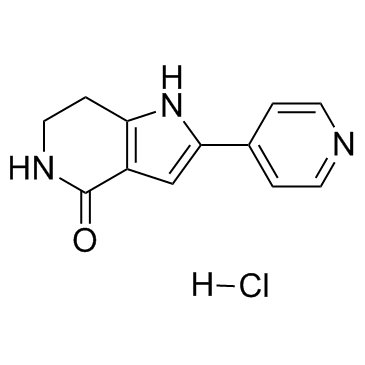PHA-767491 hydrochloride
Modify Date: 2024-01-19 17:58:03

PHA-767491 hydrochloride structure
|
Common Name | PHA-767491 hydrochloride | ||
|---|---|---|---|---|
| CAS Number | 942425-68-5 | Molecular Weight | 249.69600 | |
| Density | N/A | Boiling Point | N/A | |
| Molecular Formula | C12H12ClN3O | Melting Point | N/A | |
| MSDS | Chinese | Flash Point | N/A | |
Use of PHA-767491 hydrochloridePHA-767491 hydrochloride is a dual Cdc7/Cdk9 inhibitor, with IC50s of 10 nM and 34 nM, respectively. |
| Name | 4H-Pyrrolo[3,2-c]pyridin-4-one, 1,5,6,7-tetrahydro-2-(4-pyridinyl)-, hydrochloride |
|---|---|
| Synonym | More Synonyms |
| Description | PHA-767491 hydrochloride is a dual Cdc7/Cdk9 inhibitor, with IC50s of 10 nM and 34 nM, respectively. |
|---|---|
| Related Catalog | |
| Target |
CDK9:34 nM (IC50) CDK2:240 nM (IC50) CDK1:250 nM (IC50) CDK5:460 nM (IC50) GSK3-β:220 nM (IC50) Mk2:470 nM (IC50) Plk1:980 nM (IC50) Chk2:1100 nM (IC50) |
| In Vitro | PHA-767491 inhibits proliferation in both cell lines with an IC50 of 0.64 µM in HCC1954 cells and 1.3 µM in Colo-205 cells. PHA-767491 is effective DDK inhibitors in vitro, with IC50 values of 18.6 nM. PHA-767491 (2 µM) completely abolishes Mcm2 phosphorylation by 24 hours in HCC1954 cells[1]. PHA-767491 in combination with 5-FU exhibits much stronger cytotoxicity and induces significant apoptosis manifested by remarkably increased caspase 3 activation and poly(ADP-Ribose) polymerase fragmentation in HCC cells. PHA-767491 directly counteracts the 5-FU-induced phosphorylation of Chk1 and decreases the expression of the anti-apoptotic protein myeloid leukemia cell 1ine[2]. PHA-767491 (0-10 µM) decreases glioblastoma cell viability in a time- and dose-dependent fashion, with IC50 of approximately 2.5 µM for U87-MG and U251-MG cells. PHA-767491 hydrochloride induces apoptosis in glioblastoma cells, suppresses glioblastoma cell proliferation, cell migration and cell invasion[3]. |
| In Vivo | PHA-767491 decreases Chk1 phosphorylation and increases in situ cell apoptosis in tumor tissues sectioned from nude mice HCC xenografts[2]. |
| Kinase Assay | 20 ng of purified human DDK is pre-incubated with increasing concentrations of each DDK inhibitor for 5 min. Then 10 µCi (γ)-32P ATP and 1.5 µM cold ATP are added in a buffer containing 50 mM Tris-HCl (pH 7.5), 10 mM MgCl2, and 1 mM DTT and incubated for 30 min at 30°C. The proteins are denatured in 1X Laemmli buffer at 100°C followed by SDS-PAGE and autoradiography on HyBlot CL film. Auto-phosphorylation of DDK is used as an indicator of its kinase activity. 32P-labeled bands are quantified using ImageJ and the IC50 values are calculated using GraphPad. |
| Cell Assay | For assays in 96 well plates 2500 cells are plated per well. After 24 hours, cells are treated with small molecule inhibitors and incubated for 72 hours at 37°C. Subsequently the cells are lysed and the ATP content is measured as an indicator of metabolically active cells using the CellTiter-Glo assay. IC50 values are calculated using the GraphPad software. For assays in six well plates, 100,000 cells are plated per well. After 24 hours, cells are treated with small molecule inhibitors and incubated for varying time points. Cells are trypsinized and a suspension is made in 5 mL of phosphate buffered saline. 30 µL of this suspension is mixed with 30 µL of CellTiter-Glo reagent followed by a 10-minute incubation at room temperature. Luminescence is measured using EnVision 2104 Multilabel Reader and BioTek Synergy Neo Microplate Reader. |
| References |
| Molecular Formula | C12H12ClN3O |
|---|---|
| Molecular Weight | 249.69600 |
| Exact Mass | 249.06700 |
| PSA | 57.78000 |
| LogP | 2.49340 |
| Storage condition | -20℃ |
| pha 767491 hydrochloride |
| 1,5,6,7-Tetrahydro-2-(4-pyridinyl)-4H-pyrrolo[3,2-c]pyridin-4-one hydrochloride |
| PHA-767491 (hydrochloride) |